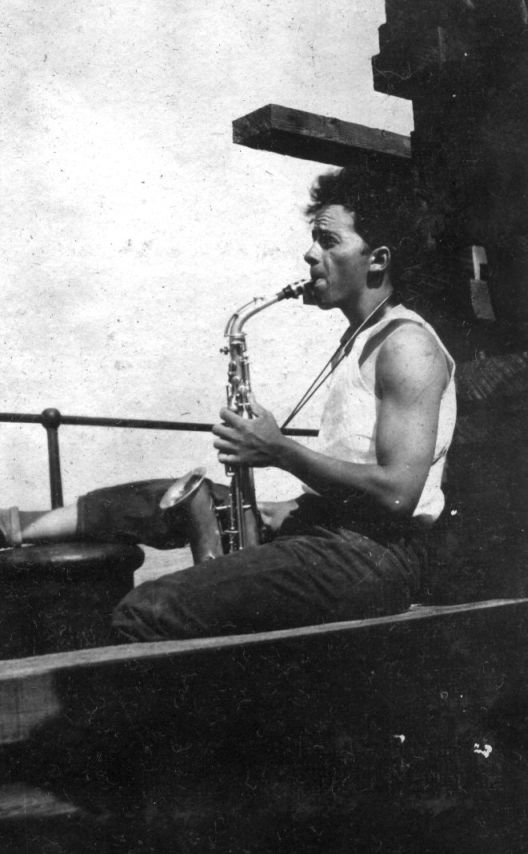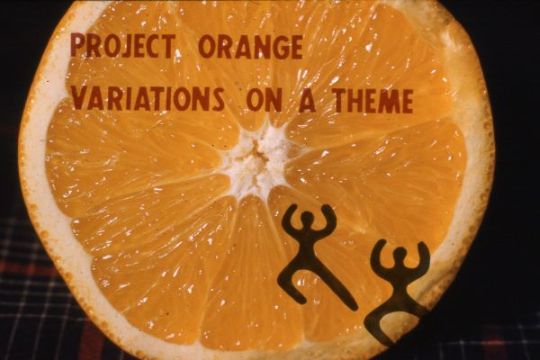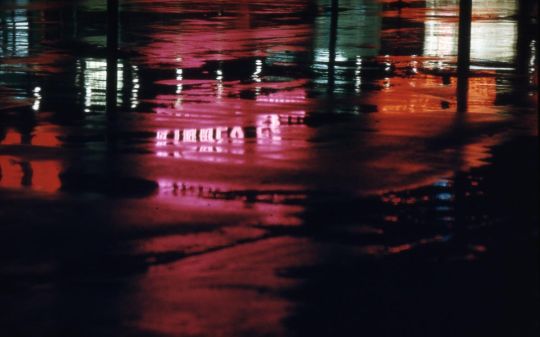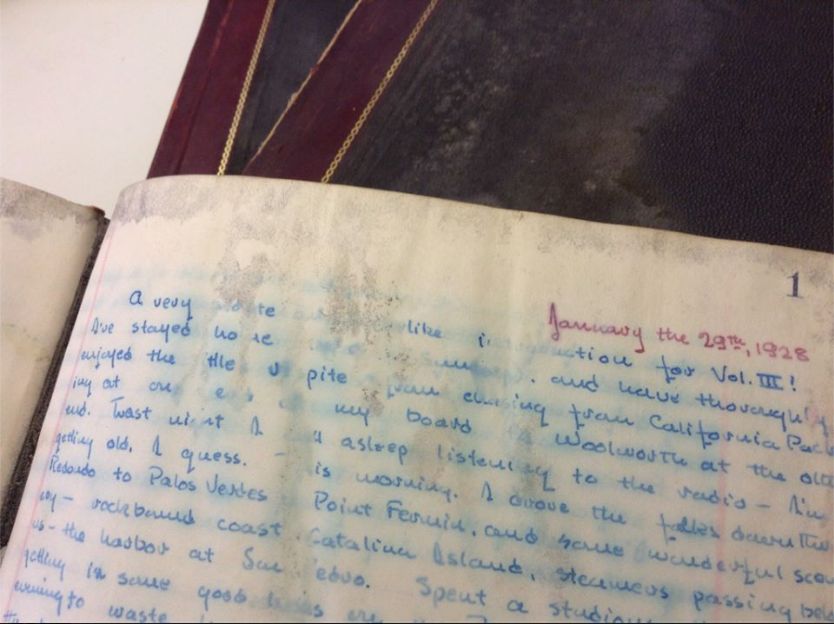
Frank playing his alto sax on deck, probably in 1924
Frank's story begins with the October 1904 marriage of two Bloomington High School sweethearts, who spent their honeymoon at the St. Louis World's Fair. Frank's father Charles, who had wanted to volunteer for the Spanish-American War but who wasn't yet 18,1 instead had taken a job with the railroad--first with the Monon Line to Chicago, and later with the El Paso-Southwestern Railroad (which ran from El Paso to San Diego). Frank's mother Alice was in Bloomington, Indiana for the birth of her first child, Frank Seward, on October 18, 1905.
Frank's lifelong love of Mexico perhaps dates from his father's work on the Nogales-Guaymas branch of the Southern Pacific Railroad, the S.P. de Mexico. Frank's Uncle Norman, a feature reporter on the El Paso Herald, was doing a series of stories on the famous outlaw, Pancho Villa, and there were stories of a hurried trip out of Mexico because Pancho was on the rampage. In 1910 Frank's father left the excitement of railroading and took a job with Consolidated National Bank, and he built the Granada Street (now Avenue) house in Tucson, Arizona.
As for Frank's early years, we do know that he wore glasses for awhile around the age of seven, that he started his lifelong hobby of stamp collecting around that age, and that he was the ringbearer in the wedding of his Uncle Fred Seward to Dorothy Hopper in Bloomington in 1914. We also know that in high school Frank signed his name with a picture of a cartoon character, named Calliope Jones--a wild western figure with droopy mustache and frontier hat.
Frank's brother Charles remembered being particularly impressed with his big brother's cartoon skills. He also remembered Frank's chemistry lab in the upstairs bathroom of the Granada Street house, where he did scientific experiments and developed the pictures he took with his Kodak folding camera.
There was a 1922 trip to Mexico on the pagadora (pay car) with boyhood friend Sheldon White (also the son of a Bloomington, Indiana family, who was best man in both of Frank's weddings). Both were students at the University of Arizona from 1922 to 1926. During the summer of 1924 Frank served as a cadet on a Dollar Line lumber schooner, the Diana Dollar. Its route began on the West Coast, went through the Panama Canal and on to New York City and Portland, Maine, with stops at Philadelphia, Baltimore and Boston, plus a week's stopover loading steel ship plate in Balboa, the Canal Zone. There was a tour of Washington, D.C., and many stories home about the duties of a general seaman on a lumber ship.

Frank playing his alto sax on deck, probably in 1924
While attending the University of Arizona, Frank and Sheldon did well on the swim team, and Frank served as the football team's business manager. He graduated with a degree in Chemistry in 1926. Meanwhile, the family had moved to Los Angeles from Tucson in September 1924.
After his graduation in 1926, Frank took a job in an 8-piece jazz band, called Lee Young's Melody Makers. Lee's wife-to-be was the piano player, Frank's sister Elizabeth. There is a picture of the band members in a rowboat at the Gables Beach Club, and brother Charles remembers a New Year's Eve gig on the local radio station, where the Melody Makers put down their instruments and clapped like crazy to suggest there was an audience present in the radio station atop the Santa Monica pier.
In the fall of 1928, five members of the Melody Makers took off on a 4-month cruise around the world on the Dollar liner, the President Wilson. Although the band played each evening after dinner, as well as for every mid-day meal, one wonders whether his fellow band members ever realized that Frank never learned to read music. His "good ear" took him around the world. The jazz band broke up after the cruise, and Frank resumed his lifelong interest in classical music. During the 30s one of Frank's greatest joys was to gather together a group of friends to discuss "good music" (and maybe, politics too).
Frank took a job at Bayly Brothers, a stockbroker on 7th Street, downtown Los Angeles, where he met Gladys and began dating her. They were working at Bayly Brothers on Black Tuesday, October 29, 1929, the day the bottom fell out of the stock market. Frank and Gladys were married on June 4, 1932 in Glendale, and they lived in a honeymoon cottage on 17th Street in Santa Monica. Gladys' daughter, Katie, then 7, remembers joining them every morning for a 6 a.m. ocean swim behind the breakwater. This being the Great Depression, jobs were hard to come by, and Frank worked in an equestrian supply shop, as an accountant at the County Department of Charities, and in September 1940 he went to work at Lockheed Aircraft, where he remained until his retirement in 1970. He never returned to the field of Chemistry, feeling that the jobs would be going to younger men who had advanced degrees in the field.
Son Jon was born in 1937, when Frank and Gladys were living on Oak Street in Santa Monica, and brother Charles and his new wife Helen were living with them to share expenses. Karen was born in 1941, when Frank and his family were living on Vanowen Street in Van Nuys. Sally was born in 1945, and by then the family lived on Sherman Way.
In addition to working at Lockheed, Frank was spending his early mornings caring for his Victory Garden. There were strawberries, artichokes, and asparagus, plus seventeen resident walnut trees, whose nuts would need to be hulled, then dried and sold at the family's road-side stand. There were also several goats, chickens, and rabbits as well as a cat named Charley and, eventually, a dog named Jill.
Now for the grab-bag section of Frank's story, with undated entries all thrown together, although in somewhat chronological order.
Elizabeth remembers her big brother would always take his saxophone on trips to Sabino Canyon, near Tucson. She remembers him sitting on a big rock, playing to a circle of girls who were enthralled with the music.
Frank's sister Pat remembers her big brother trying to teach her to swim at the State Beach. The waves would cash over her head, and she remembers her desire that he drown in the process. But since she is still a water rat, she feels there must have been something quite special in his technique.
One of brother Bill's most vivid memories of Frank was his taste for beer and wine. It was 1929 or 1930, the family lived on 21st Place in Santa Monica, and the house had a huge basement. Bill used to help Frank bottle his homemade fig wine and beer which he made in five-gallon crocks. Bill admits he can still smell the fumes, and it must have been fifteen years later before he would even take a sip of wine.
Katie remembers "Frank the Hero," who courageously took on the fire-spouting iron. She was busy ironing with Big Mama's iron, which must have dated to the 1890s, when the iron and its cord decided to part company. The cord was still plugged in and began to dance around the room, showering sparks as it went. Katie jumped on the bed and started to scream, which drew Gladys, who fainted in the doorway. This drew Frank, who calmly stepped over Gladys, told Katie to hush up, and proceeded to pull the cord from the wall. The fireworks were at an end, and Frank was the hero of the day.
Katie tells of the night Bob came to visit her, and Bob found she had another date sitting in the living room. Bob summed up the situation quickly, when Frank came to the door. He remembers Frank's stunned expression when Bob insisted he was only there to see the goat.
Katie recalls the day that she was typing her senior paper while little Sally was playing in the backyard. Commotion ensued, and Katie looked out to see Midgely's bull had escaped the neighbor's yard and was attacking the clothes on the line. Sally was retrieved, the police called, and a cowboy was hired to coax the bull back next door. Such was the excitement at Casita de las Rosas, the Sherman Way house.
Frank and the "Work Ethic." During the gas rationing days of World War II, Frank used to ride his bike the ten or so miles to Lockheed, in Burbank, so as to conserve gasoline.
Katie remembers the day of her wedding shower, when Frank covered the front lawn with chicken manure.
Frank put in many hours trying to correct Karen's pronunciation of her kindergarten teacher's name: not, "Mrs. Fannigan," but "Mrs. Flanigan."
Karen remembers the family getting all dressed up to go to Grandma's house, and Jon starting to tease her. She got out the hose and gave him a good dousing, party clothes and all. Frank threatened a good spanking, but she distinctly remembers that her promises that she'd never do it again, worked. She remembers getting away with a good many things thereafter, as long as she tearfully promised her daddy she'd never do it again.
There was the night the garage fell down. Katie and Bob had recently gotten married (they'd eloped during the great snowfall of January 1949). Some friends had come over to help move the garage to the other side of the property because the Back 40 had been sold for subdivision. About five days later there was a terrible crash in the night, and both Frank and Gladys raced out into the night, certain that the garage had fallen down.
Unfortunately, if that crash was the one Karen remembers as the subject of a newspaper article titled "Killer Tree," it was a tragic automobile accident that involved one of the trees that lined the property along Sherman Way. The incident involves her earliest memories of the Van Nuys courthouse, her mother's testimony in the case, and many questions about the workings of our justice system.
Charlie Carey remembers that as a small boy, going to Van Nuys was a big event. The 1941 Plymouth headed up Sepulveda and through the Mulholland Tunnel, and "out to Uncle Frank's in the country." He tells of the Easter egg hunts, and especially of the year when he, as one of the "big kids," got to hide some of the eggs. He fiendishly hid some in ingenious places, hoping they would rot before being found. Alas, the grown-ups were onto the plan, and they insisted that each of the eggs be found.
We understand that Frank hated turnips, ate rice only with sugar on it, and that he frequently had such potent dreams (after eating mushrooms?) that Gladys used to tease him about the squirrels chasing him. There was Frank's favorite record "Rum and Coca Cola" by the Andrews Sisters, which so offended Gladys that it was hidden for many years in the gift-wrapping drawer in the dining room.
Frank was also an armchair mountain climber, enjoying the tales of the first expedition that conquered Mt. Everest. Karen remembers trekking up Kearsarge Pass in the Sierras in 1953 with her dad, to meet her brother Jon's scouting expedition, on Jon's 16th birthday. Frank has received whistles, wearing Bermuda shorts, and he once lost the seat of his pants, after sitting on a rock near the steam pots of Mt. Lassen, to change film.
Photography and Project Orange: There was a period of time when anything and everything orange became the subject of a double or triple exposure. Project Orange made a great hit with the students in the Photography classes he taught for thirteen years in Valley schools. Frank also regularly exhibited his color slides in national competitions and was the recipient of many stars and awards in photographic salons.

Frank's Project Orange title slide, which he used to introduce different compilations of orange-themed photos
There is a story from Honolulu, dated Christmas 1970, that Frank was seen dancing around the Christmas tree with Katie's father-in-law Claude Beatty, after a particularly eventful Christmas evening. Frank was photographed in the act of being a matador (Karen was the bull), Jon was pictured lying on the carpet with a bright red bow on his nose, and Frank was found "watering," or "hosing down" the bushes in the front yard. That was also the Christmas when Frank was chosen by the Hawaiian neighbors to be the official priest, with the duty of blessing the pig as it was being roasted for the luau.
Frank's love of gardening goes way back. Little Sally's earliest memory of her father was walking with him through the rows of his iris garden, with the flower stalks stretching taller than she could reach. He was by that time the President of the Southern California Iris Society, and one of Karen's earliest memories was rising and dressing before the light of day, stuffing the skirt of her grade-school dress into her overalls so she could follow him through the garden to keep the records of which iris was being mated with which other. She also remembers that her dad would frequently compare iris stories with LaVerne Conrad, her most attractive Girl Scout leader who had a flair for iris fanciers.
He always enjoyed working with seeds, picking them up from exotic places or even filching them from friends and neighbors. Once pocketed, they would find their way into a pot in his lath house. After a heavy day at Lockheed he could always be found either taking a few puffs on a forbidden cigarette out behind the barbecue, or invariably, tending his assortment of sprouts in the lath house.

Frank titled this photo "Rainy Night"
Karen remembers questioning her dad, who had just turned 90, about his lack of religious beliefs. She remembers jesting with him about Gladys's prophesy that he would request a Catholic priest to give him the last rites when his end was near. A self-professed longtime atheist, Frank laughed and said no, he had no such whim, but if he did have to choose, he certainly preferred the Catholics, because of their acknowledgement that both good and evil exist in the world, to all those "... damned Protestants, with their home-improvement plans for the human soul."
Now back to the chronology. Frank met Sally Beach in the spring of 1971, soon after Gladys had passed away. They were introduced by their old friend, Sheldon White, who became their best man in November 1971. They were close to celebrating their 25th wedding anniversary in 1996, when Frank went into the hospital. He passed away just one day after celebrating his 91st birthday, at high noon.
Karen Walker Evarts
October 2005
Thank you, Karen for contributing a beautiful biography of your father!
In 2013, Karen was contacted by a man in northern California who claimed to have some diaries of Frank Seward Walker, written from 1928 to 1932, in his possession. He had tracked Karen down by googling Frank's name and finding information on him at this web site. Although, at first, Karen was skeptical, this turned out not to be any kind of scam. The diaries were shipped to her and she has shared a photo of their first page with us, via her Facebook page. We hope she will take good care of the diaries and will make at least some of their contents available to us.
For the benefit of our readers who may not have access to Facebook, we are providing that picture here, along with Karen's comments:

Page one, dated January 29, 1928, of dad's journal, in the worst shape, water-damage wise.
Can just make out a drive from Redondo to Palos Verdes, Pt. Fermin, Catalina in the distance.
In next page or two, interviewing for a band gig on a round-the-world steamship, discussion of making bathtub gin ...
No wonder some book seller kept these journals for 80 years. Dad would have been 22.